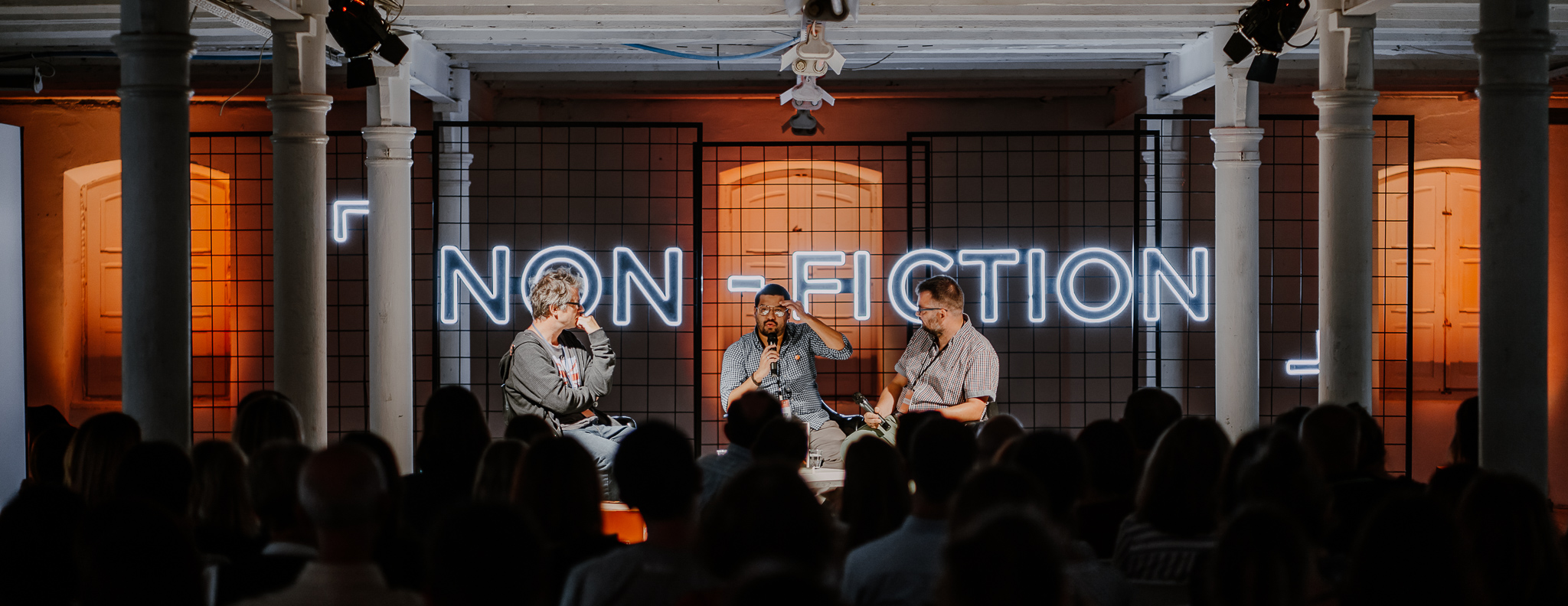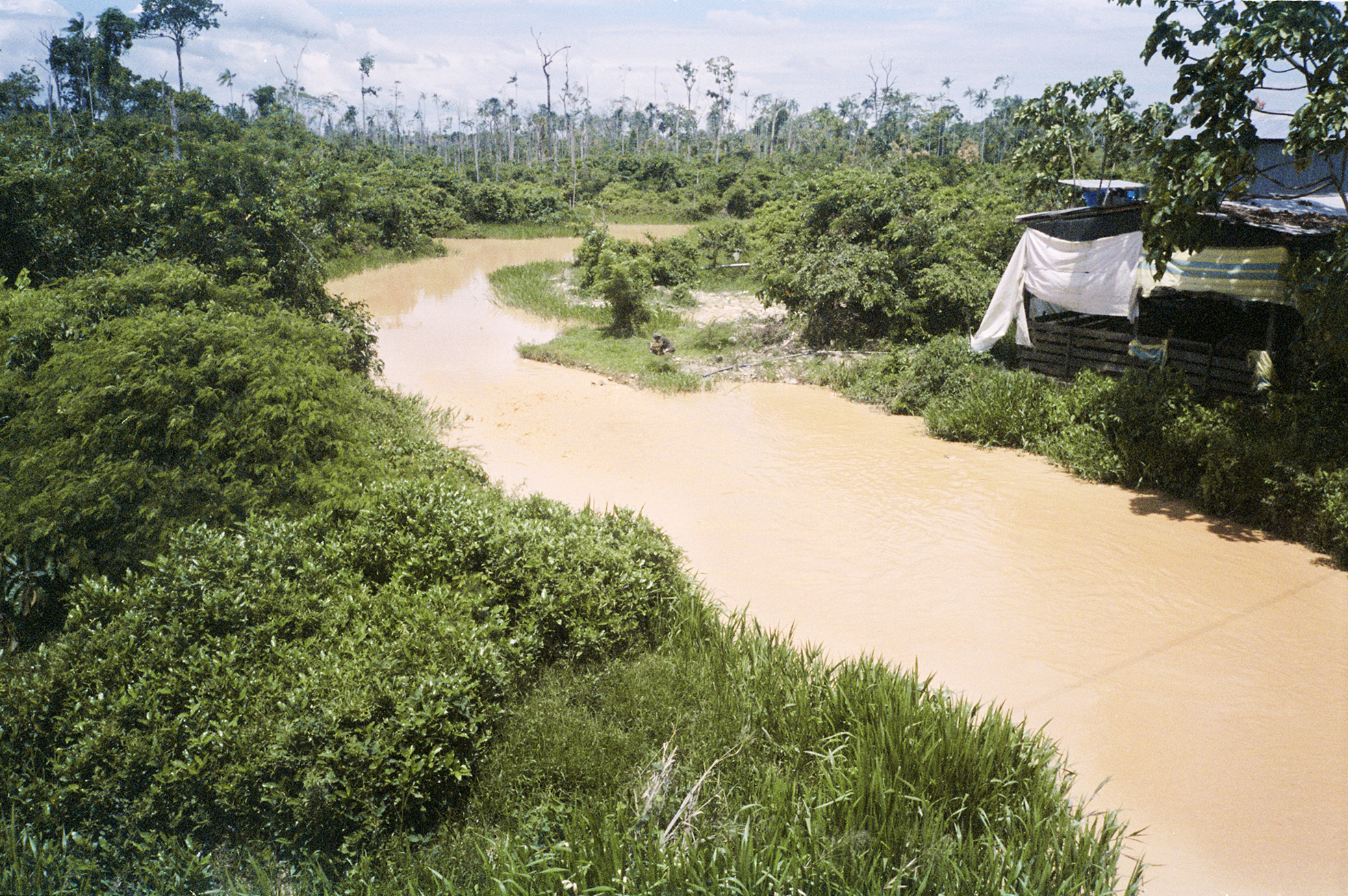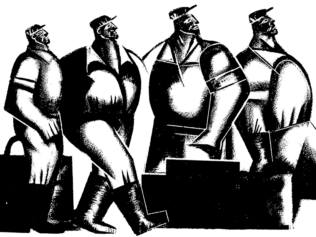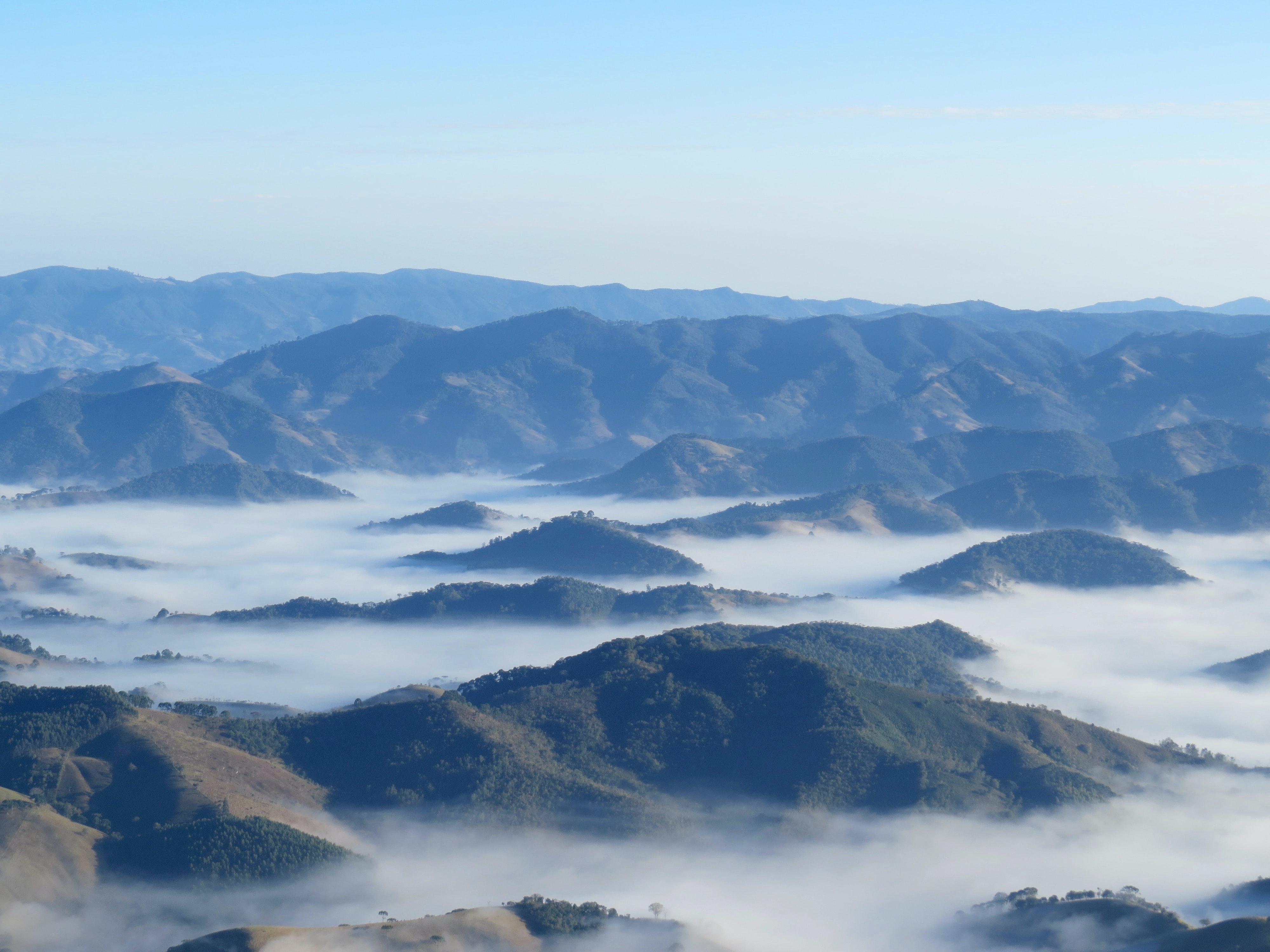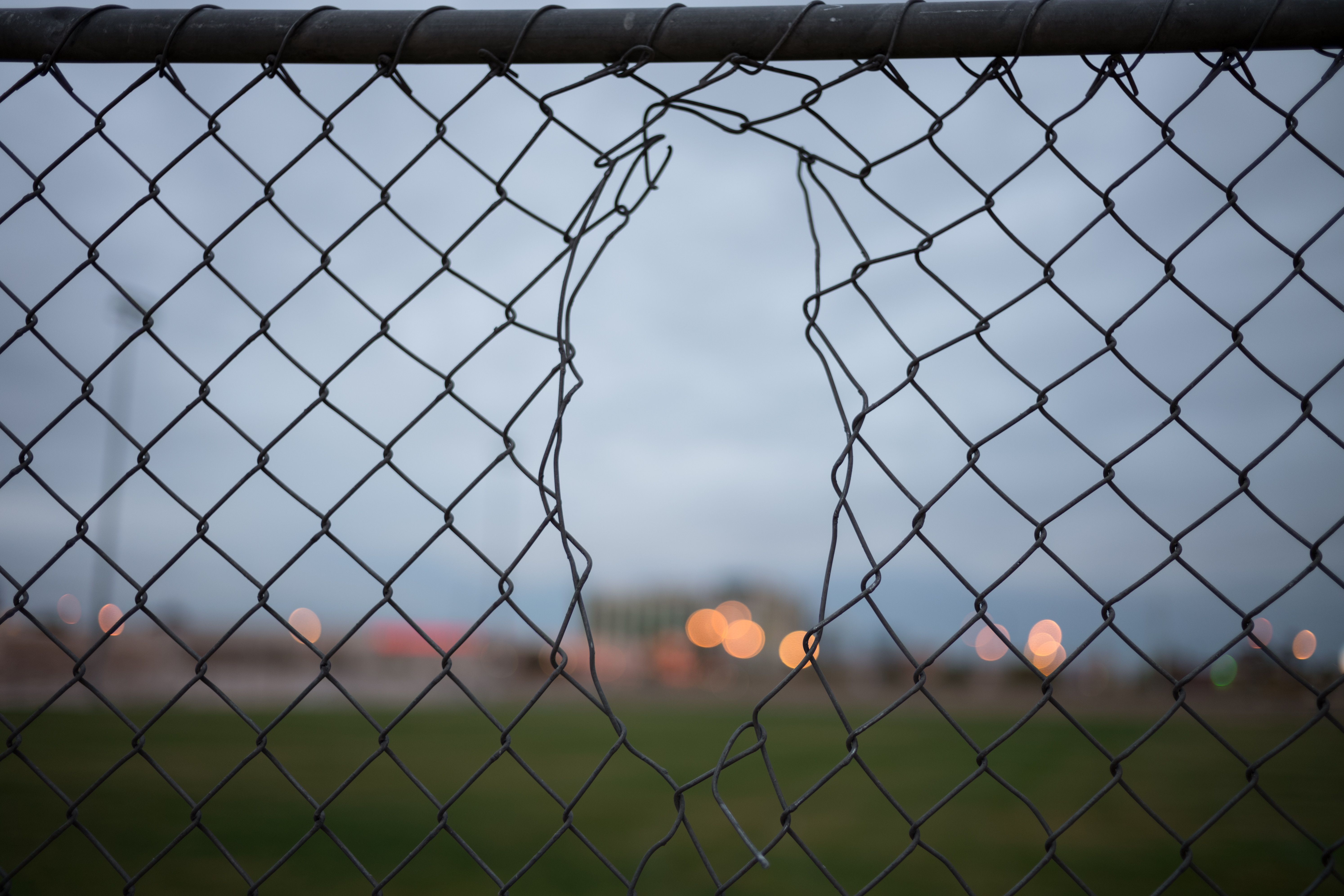
“If I didn’t believe in the idea that journalism can change things, I wouldn’t do it,” says Óscar Martínez. “But I don’t believe it’s the best job in the world. The best job in the world is to work on the beach in Oaxaca.” The journalist from the online newspaper El Faro has written books on migration and organized crime, winning numerous awards. Aleksandra Lipczak caught up with him at the NON-FICTION reportage festival in Kraków.
Óscar Martínez became a journalist as a young boy. He wanted to do important things. A dozen years later, he can say he’s a leading reporter both in his native El Salvador and in all of Latin America. As a reporter, he’s been taken up by two great themes: migration and organized crime. He has worked on the latter for many years in the well-known online daily El Faro, where he founded the ‘Sala Negra’ section, now a cult publication on the phenomenon of violence in Central America.
His best-known book, The Beast: Riding the Rails and Dodging Narcos on the Migrant Trail, discussing migration and the travels of Central American migrants through Mexico, was published in Poland this year by Sonia Draga Post Factum.
“I come from a country where there was a civil war,” Martínez says during a meeting with readers during the NON-FICTION reportage festival in Kraków. “I’ve never lived in peace. From the beginning of my work as a journalist, and I started at a young age, I’ve written about violence. I worked in Iraq. But I never saw violence and impunity of criminal groups like I saw in Mexico. Violence against migrants there is extreme. You can call it a humanitarian crisis.”
We speak just before this meeting. Martínez is direct, friendly; he doesn’t like to talk about himself. He asks me about Poland, about our experience with migration. But he could talk for hours about the problems he works on. “It’s no problem, keep on asking,” he says when I glance at my watch, worried he’ll be late. He cares about being well understood. After all, the stories he tells aren’t that far from the European reality, he believes. “Maybe the context is different, but the mechanisms that govern migrations are the same today, regardless of geographic distance.”
Aleksandra Lipczak: Cuerpomátic – the bodymatic. That’s the detail of your book that seems to have stuck in my mind the most.
Óscar Martínez: This term was adopted by migrant women travelling through Mexico without documents. They have no escape, and they agree that during their travels their bodies become their currency to pay for safety, care, and sometimes simply for life. They often get condoms from their coyotes (people smugglers), because it’s very likely that they’ll get raped along the way, so it’s better to have them on hand.
Another detail I can’t forget is La Arrocera.
For me this was also one of the places that has lodged most deeply in my memory. It’s a wild land not far from a small settlement in Chiapas state called La Arrocera, for the rice warehouse that stands along the road. One of many places along the back roads of Mexico that the migrants use to evade the authorities.
In La Arrocera, two things struck me: the disinterested cruelty of the residents, and the complete lack of interest in the migrants on the part of the state. The people who live there saw a business opportunity in the trails of people winding through their villages. For many years, on a mass scale, they raped the women passing through there, and stole whatever the men had with them. Often these were exceptionally cruel rapes, for example in front of the entire family. They happened without the participation of gangs – completely from the grassroots, if you can call it that.
In the case of this particular place, the book managed to change something. This should have happened long ago, because there were far too many testimonies of what was being done there. But it took several years of our efforts, reports and appearances in parliament for the Mexican state to do something about it. The women around La Arrocera and along the entire route that leads through it are safe now, but the same thing is starting to happen in other places. The main roads are controlled by the police and the army, so the migrants shift to the mountains, and there are increasing reports of attacks and rapes there. It will be this way as long as the authorities don’t want to acknowledge that migration can’t be stopped, it can only be regulated.
From the media, we primarily know an image of Mexicans as the victims of Trump’s migration policy. But The Beast is a report on the hell caused for the migrants by the Mexican state – or rather, the lack of a state.
Many Mexicans are undoubtedly the victims of the border, the wall and deportations. But Mexico is really a giant, and it has many different faces. There’s the Mexico for tourists – beautiful, developed, safe. There’s the Mexico of the big cities – complex, dynamic, difficult. And finally, we have the hidden Mexico – the small towns and villages, the forgotten regions where the state has been pushed out by organized crime.
In many places that I visited with my photographers, the gangs are in charge; they set the rules of society and kill with impunity. After all, this doesn’t just happen in small towns. During our time in Nuevo Laredo, a city of 370,000 people on the US border, the cartel killed more than 20 policemen and hung their bodies up across from city hall, in pig masks. But the next day the cover story of the local newspaper was about a mass. The silence that the gang imposed on the city was shocking.
Just as shocking is the awareness that you’re in a place where if somebody decided to murder you, there’s no force that could stop them. There’s no escape from this verdict.
The Beast isn’t a new book. What’s changed on the migrant trail since you wrote it?
The book was written a decade ago, but there are things that haven’t changed by even a millimetre. It would be hard for that to happen, because the gangs have found a gold mine in the migrants. Kidnapping for ransom, collecting protection money from the coyotes, human trafficking and forcing migrants into prostitution: all of this is still happening in Mexico, and on a huge scale.
The migrants are the ideal victims. They don’t vote, they don’t report crimes to the police, they’re only passing through Mexico, and on top of that, illegally. They have the misfortune that to get to the US, they have to pass through a country ruled by organized crime. They don’t pass through the Mexico of big cities or the Mexico of tourists. The Beast, the train whose roof they usually ride on, passes through forgotten landscapes and small pueblos, where the gangs are the state. There, the police and the cartel are so tightly allied that there’s no way to tell them apart.
During the 10 years since I wrote the book, only some details have changed: the names of the gangs, the places they operate. Los Zetas have moved from the south to the north. Earlier there were mass rapes of migrants in the Pacific region; today the cursed places are multiplying by the Atlantic. The map of violence is mutating, but its essence remains the same.
In The Beast, you capture the moment of a paradigm shift, if you can call it that. The gangs are taking over the migration business, but many of your interviewees remember how it was before, when everything was organized from the bottom up.
From the beginning of the mass migration from the south, there were cartels in Mexico that collected payments for the journey from the migrants. But these were small-time affairs; it usually never went as far as violence.
When Los Zetas – earlier an armed branch of the Cártel Del Golfo, their killers – broke off and created their own gang, they started to diversify their operations, and as part of that diversification they started to take over migrants. Since then it wasn’t just collecting protection, but also controlling the coyotes, trafficking in women, kidnapping for ransom. Even in a country with such a high tolerance for violence as Mexico, what they did to the migrants, the scale of the murders and cruelty, was shocking.
Now Los Zetas operate only in the north of the country, but other criminal organizations have realized what a lucrative business the migrants are. That’s the lesson Los Zetas have left behind.
We’re seeing the first signals that other gangs have taken over the business in the south. The younger Jalisco Nueva Generación has already notched up its first kidnappings.
In Europe and the Mediterranean, gangs are also making millions transporting migrants who have no way to apply for visas or asylum where they live.
Western governments’ migration policy stuffs the criminals’ pockets the same way everywhere. Since Trump came to power, the coyotes’ prices in Mexico have risen. These are businesspeople. If you’re a driver and the cost of fuel goes up, you raise the cost of transport. They’ve used Trump’s propaganda about closing the border to raise their prices. From a technical point of view the coyotes are smugglers, though this word seems a bit too high-flown. Of course, there are bad people among them, who traffic women, for example. But others are more respectable, because they’ve managed to transport half of a town to the US.
You used to pay the coyote in your village in El Salvador, and he’d accompany you to the door of your family in Houston. But the criminal groups changed the logic of smuggling. On the border, the Salvadoran coyotes transfer their clients to other coyotes, and halfway through the country they’re passed on to others, and so on. The division of the route allows the cartels to control the business better. The migrants who don’t use their services risk their lives, because they’re not helping the cartels make money.
The gangs have changed the history of migration in Mexico. The model of the coyote viajero, the ‘travelling smuggler’ as they’re called in El Salvador, who accompanied their clients for the whole route, has really died out; migration has simply become just another area of organized crime.
The violence that’s been unleashed by the cartels is a tragedy that will leave traces for decades.
Are there people in Mexico who are trying to oppose this? You write in the introduction to the book that they’re drops in the ocean, but I’d like to know more about them.
They’re the true heroes. They live there, they work, run shelters for migrants, fight for their rights and have scored certain successes. But recently they’ve suffered a great disappointment. The new President of Mexico, Andrés Manuel López Obrador, said during the campaign that he’d work on regulating migration. The idea even appeared of creating a humanitarian transit visa. But in recent months, Trump threatened Mexico with tariffs of 25% if it doesn’t stop the migrants. The López Obrador government caved in like all of its predecessors. Today López Obrador – the one who was supposed to make revolutionary changes – is putting into practice a brutal policy of repression against the migrants in southern Mexico. He’s engaging not only the police but also the army to stop the migrants. He chickened out. Mexican NGOs have gone back to square one and the role they’ve always played: bearing witness to tragedies, being all-observing eyes. Other than that, they’re powerless. This is a very difficult moment for Mexican activists.
It went the same way in Spain: the Socialist Prime Minister Pedro Sánchez started his rule by accepting the refugee-carrying ship Aquarius, which no other state wanted to let in, but soon after that he cut off financing for maritime rescue and agreed with Morocco on stopping migration to Europe.
Migrants are a great negotiating card. They don’t vote, so nobody cares what they think. Aside from that, let’s be honest, the citizens of countries they travel through or to don’t give a damn about them. Of course there are exceptions, but you can’t say that Mexican society is consumed with what happens to the migrants, or that the Spanish and Italians can’t sleep at night because they’re worried about what’s happening on the Mediterranean. Many people, including in Mexico, openly hate them, latch on to slogans about invasions and so on.
In the case of Mexico, it’s even more bitter because Mexico itself is a country of migrants, hundreds of whom leave for the US every day. But it agrees to play the role of regional policeman, who makes it impossible for others.
The almost disinterested cruelty of people toward migrants on the trail seems to be the most soul-crushing part of your book. Quite a gloomy reflection on human nature flows from it.
I don’t like to theorize. I don’t know whether this violence results from human nature, or it’s more an effect of a certain social construct, a message we take in starting in childhood, and which tells us that we compete or fight with others rather than cooperating. Contemporary neoliberal societies are machines for creating this kind of thinking. To go forward is a solitary enterprise. A poor person stomps other poor people into the earth: I’ve seen it more than once in Mexico, and it depressed me greatly.
When I finished the book, I spent a lot of time with migrants who had managed to make it to the US. They repeat these same mechanisms. If somebody puts a stumbling block in their path, very often it’s other immigrants. In addition to the scandalous corruption and violence of organized groups, while writing The Beast I saw a lot of human misery – in the broad sense of that word. Here I’m thinking of the victims, human beings transformed into eternally frightened animals, and of their torturers, who – this sounds banal, but I don’t know any other way to put it – when circumstances allowed it, became bad people. On the principle of: I’ll rape this woman, because I can. I’ll take 100 pesos [approximately $5] from this person and use it to buy a taco.
For me, the migrants’ path became something like a metaphor. A picture of what happens when you meet people in a world without principles. The result is: people devour each other.
In The Beast, you have an interesting reflection: violence, in this case against migrants, sooner or later attacks the society that allows it.
It’s delusional to think that violence will remain in a limited space, that it will always affect others, not us. In the end, the border between ‘them’ and ‘us’ gets blurred. In a country that allows growth in the level of violence and impunity, in the end they start to affect everyone; they spread like a cancer. If something becomes possible once, nothing can stop it from happening again, in another context and to other people. The logic of ‘this only happens to other people’ is absurd, because the walls of the information and identity bubbles we live in are leaky.
In Mexico, there hasn’t been a single verdict yet in a case of abusing migrants. And when there’s no functioning justice system, impunity appears. I know what I’m talking about, because I myself come from El Salvador, a country built on impunity. The civil war – cruel, full of senseless violence – ended in an amnesty. Nobody, nobody at all paid for war crimes, massacres, tortures, sexual crimes; and nobody asked the victims what they thought of this. Communities that haven’t had an honest reckoning with their past have a tendency to repeat the crimes they’ve committed. The message that comes from the top is: you can do what you want, you won’t be punished. This is a disastrous foundation for building a state.
You say the people leaving your country aren’t migrating so much as escaping. From what?
They get threats; their lives are in danger and they have to leave the country as soon as possible. If you’re migrating, you usually do it with some kind of plan; if you’re escaping, you don’t think of the consequences. The difference between these two verbs is the difference between seeking a better life and seeking a place to live at all.
I come from the region of the world that has the highest murder rate. From there, you just escape. It’s a complex reality, and I don’t know how best to describe it to somebody from another part of the globe. I can use numbers and statistics, but I’m not sure which of them best gets the point across.
Usually we use the number of murders per 100,000 residents.
Those are such big, cold numbers. What kind of emotional charge is carried by the information that in the worst moment of the 21st century there were 103 murders per 100,000 Salvadorans?
But 103 murders is madness. In Poland, it’s 1 point something; in the US, about 5. But 103 murders means that in 2015, one out of every 972 Salvadorans was murdered. It’s hard not to know somebody, at least indirectly, who was a victim. That’s what people are escaping from, from the closeness of death.
In the end, the source of today’s violence is deportations. The two most important gangs in El Salvador – Mara Salvatrucha and Barrio 18 – were formed in the 1980s in California. From 1989 to 1993, the US government deported 4000 members to El Salvador. They returned to a country degraded by civil war and proliferated at a lightning pace. Today the number of gang members is about 60,000.
What’s life like in such a country?
Many people wake up every day with the awareness that they can be murdered. Or with the fear that something bad could happen to their children. So their daily lives consist in avoiding the worst. They don’t live in a country, they live in the ruins of a country. If you’re unlucky enough to be born in a neighbourhood controlled by Mara Salvatrucha, you can’t walk down a street controlled by Barrio 18 without risking your life. If they stop you and tell you to show your documents, you’ll be killed on the spot. For many people, getting from point A to point B is a complicated puzzle.
Growing up in such conditions is something monstrous. It creates paranoid societies. People live in constant fear, and a society that fears is submissive. It doesn’t have a lot of time to think, because it’s busy creating survival strategies.
Does this violence affect the middle class?
Violence in El Salvador is a completely class-based experience, and it affects the 60% of society that live in working-class districts. The privileged classes don’t have that problem. Their children are safe, and they drink $10 margaritas in bars. El Salvador is a country of social bubbles. Sometimes it seems that it’s a society from a science-fiction film, where all the poor are gathered in a single place that the rich never see.
That’s the heart of the problem. A large part of the political class of El Salvador – and also Honduras and Guatemala – doesn’t at all see it as essential to solve the problem of street gangs, because it doesn’t affect them. They won’t address it until they feel the problem in their own flesh and bone. Pablo Escobar wasn’t a problem for the politicians in Colombia either, until he started to attack them. For years he played golf with them and it was OK, because he only killed poor people. This is the logic that wins out in such socially stratified countries as El Salvador, countries of poor people governed by a handful of rich ones, who can’t understand what’s happening down below.
But recently there have been efforts in El Salvador to change political life.
For a few months Nayib Bukele, a 37-year-old businessman, has been president – a political outsider. He has no large party behind him; until recently he didn’t exist at all in politics. His career was meteoric, and he’s still a great unknown. After taking power, he surrounded himself with people who aren’t completely trustworthy. Despite it all, he seems to be a new quality in Salvadoran politics. Let’s hope he doesn’t miss this chance. It’s still too early to say anything more. For now, we journalists haven’t been able to explain very well who he is or where he came from. We’re still not able to see the full picture.
What’s his idea for reducing violence?
He started out like all his predecessors, with images of soldiers kicking down doors in poor neighbourhoods. But then he announced the ‘positive phase’ of his plan, meaning preventive actions. If he really follows through, it would be something completely new. But we’ll see how it goes for him, because there are many people who are calling for blood – and demands translate into votes.
In El Salvador, we have exceptionally bad luck in corrupt, incompetent governments. Each one in turn promises a policy of a ‘strong hand’ against the gangs. For 15 years everybody has been promising the final battle with the gangs, but the problem just increases. A dozen years ago the number of murders per 100,000 residents was 32; today it’s over 100. Even so, people still vote for politicians who promise exactly the same thing. Why? Now it’s no longer about social sensitivity or humanism. It’s a purely pragmatic question. And it’s been proven: this policy doesn’t work. It won’t bring your children a better life.
We vote for politicians who offer treatment using expired medications. The same thing is happening in the US. Trump won by promising deportations and a wall. The wall’s been there for a long time. The Democrats started building it in 1994. The one who migrant assistance organizations called the deporter-in-chief was none other than Obama. This good, liberal president deported a record number of 74 Salvadorans a day.
But these methods don’t work. Deportations bring the opposite of their intended effect, contributing for example to the growth of gangs in the US. Many deported members of Mara Salvatrucha reorganize in El Salvador and return to the US with a new burst of energy.
The way so many people buy these political slogans shows what dull and uncritical societies we are.
Do you still travel to Mexico?
For many years, I’ve been taken up by the same subjects: I write about migrants in Mexico, Salvadoran gangs, I go to the US. Now I’m interested most of all in the life of those who’ve managed to get there. I’ve already written a few reportages about them, but I’d like to live there for a while, get to know their stories better. My plan is to destroy the American Dream.
Does it still exist?
It’s a primitive way of talking about the very hard life immigrants lead – a way that lacks respect for them. In fact, they also talk about the ‘American Dream’, but they know better than anybody that it’s a fiction. But many of them are prisoners in the US. For many years they lived in hope of returning home, but they see that life in Central America isn’t getting any better. There’s no growth in prosperity, no reduction in violence, the gangs are more and more dominant. The idea of returning gradually dissolves, and for many of them this is a great trauma, because in the US they’re not even second-class citizens, but third-class. They hide, they live in fear of deportation, they work several jobs at once. ‘Nightmare’ might be too strong a word, because despite it all many of them achieve success. But it’s getting harder and more expensive all the time, and persecution of immigrants is only getting stronger.
After reading your book, it seems unlikely that anyone would try to get to the US.
Remember that in it I describe third-class migrants. Not those who can afford a flight, or a journey inside a train rather than on top. There are some who pay the coyotes for a car ride through Mexico. I’m describing those at the bottom, because only they ride on the roof of ‘The Beast’. There are much safer ways to travel. But a flight on a light aircraft costs about $12,000-13,000, while a migrant who travels by land and on the roof of a train spends about $1,500.
Your books are bestsellers in the US. Do you think you’re being heard there?
The Beast came out a decade ago and it’s still selling well, just like A History of Violence, which came out five years ago and explains what migrants from Central America are fleeing from. In theory I should be grateful to Trump, because he’s driving growth in sales of my books. People want to understand what it’s all about.
I’ll be honest: if I didn’t believe in the idea that journalism can change things, I wouldn’t do it. I don’t believe in any romantic vision, like that of Gabriel García Márquez, that it’s the greatest job in the world. The best job in the world is working on the beach in Oaxaca, not ruining your health doing reportage. But I believe journalism is useful, that ‘to know’ and ‘not to know’ makes a difference, and that making people know something has consequences.
Journalism changes the world, but it does so at an immoral pace. Let’s take La Arrocera, which we discussed: it would only take a moment to get the situation under control, but you’d have to publicize the issue for years before something happened. That’s the pace at which waves wear away a cliff, so they have to be very strong and stubborn waves.
The Beast is read at American universities, where the people who will run the country someday study. It’s just that the harm being done by Trump will still be visible for many years, even when he’s gone. He showed that you can be an open racist and that’s OK. He’s broadened the boundaries of what’s acceptable. From now on you can talk about other places as “shithole countries” and nothing will happen. Politics won’t forget this anytime soon.
Of course, this has the effect that on the other side there appear many outstanding politicians, who want to oppose Trump. But that doesn’t change the fact that from now on, we’re also doomed to have politicians cut from the same cloth as him.
And what was the reaction to The Beast in El Salvador?
People don’t read much there. For example, a book I edited, Crónicas negras (Chronicles of Crime) became a bestseller, with 300 copies sold. The Beast was read by NGO employees, it was used for political lobbying in El Salvador and the US, but if you ask about readers, it’s hard for me to assess its reach and influence. It set off a debate, but in very limited circles. I’m not sure whether migration is a subject of debate at all in El Salvador. It’s not a subject that’s discussed during election campaigns. Politicians ignore it, even though 3.5 million Salvadorans live outside the borders. That’s a huge number; the country has 6.5 million residents. But it’s very important that the money sent back by migrants amounts to about one-third of GDP.
You say people don’t read much in El Salvador, but the online newspaper El Faro where you work is a cult publication throughout the Spanish-speaking world. It’s one of the places where the best reportage in Latin America is published.
It’s interesting that a tiny little paper that started in 1998 during a meeting of friends has become what it is today. The success must be related to how at El Faro nobody ever believed you have to write briefly and simply online. That would mean you’re writing for idiots, for people who don’t want to read – and so why should you write for them at all? El Faro bet on stories with life, and journalistic projects that cost a lot.
The Beast is part of a larger project, En el camino (On the Road), about the migration trail in Mexico. In addition to the book there’s also a documentary film about women migrants, María en la tierra de nadie (Maria in No Man’s Land) directed by Marcela Zamora, and a photo essay by Edu Ponces, Toni Arnau and Eduardo Soteras. To support three photographers, two filmmakers and a journalist for three years in Mexico is a very expensive thing. But in El Faro we understood what an important project it was.
There they also understand a principle that’s disappearing from journalism: the need to stay in a place for a long time. A journalist who doesn’t stick around isn’t able to really understand and explain what they see. I don’t say that other kinds of journalism aren’t needed, but longform requires time. Reporters today are told: you have three days. Don’t bullshit me; in three days you can’t understand anything.
Where do you get the money for this?
It’s true that El Faro exists thanks to subsidies from international organizations, from the Open Society Foundations and the Ford Foundation, through Spanish and Danish international cooperation funds. Today we’re 50% dependent on them. But we’re also selling more and more ads, and managing to engage more readers as sponsors, who pay a monthly amount just because they believe what we do is important. We’re creating something that we call a network of ‘civic excavators’ – people who help us dig up hidden corruption. But we don’t have a paywall, and we never will. We think access to information has to be unlimited.
We do our job well, and there’s no other explanation for why people read us in Argentina, students at US and Mexican universities analyse us, and I end up at a festival of reportage in Kraków. Good stories have no problem crossing borders. They go beyond the facts they describe, and say something that’s understandable both in Mexico and in Poland.
The stories I write have consequences with global reach. The decor may change, but the mechanisms for controlling migration are similar all over the world.
And what price do the people who do this kind of journalism pay?
At El Faro we sometimes have security problems, from time to time we have to send our reporters abroad; I myself had to leave El Salvador once, because I started to get threats. But that’s nothing in comparison with what our sources go through. Some have been killed, others are persecuted.
You’re asking about personal consequences? Working on this kind of story changes you as a person, of course. There’s a lot more darkness in me. But I try to think as little as possible about what journalism has done to me. To be honest, it doesn’t seem particularly interesting to me. You can’t tell the story of a storm without getting a little wet. But I only go out for a little while, I don’t have to deal with the rain every day. I always try to remember that.
In the book, I use the first person mainly when my own body becomes a channel to transmit information about experiences: cold, exhaustion, fear. In all of these situations, I was just a guest. Those who really had to go through it are the heroes of my stories. It happens that I say something in an interview about my own experiences, but then it usually makes it into the headline. The world likes to create heroes. A journalist who writes about violence can easily become one of them, even though they’re just doing their job, period.
Journalism has brought me many good things: lectures in the US, a little money, a trip to Poland. So I don’t feel comfortable answering a question about the ‘price’.
Parts of this interview have been edited and condensed for clarity and brevity.
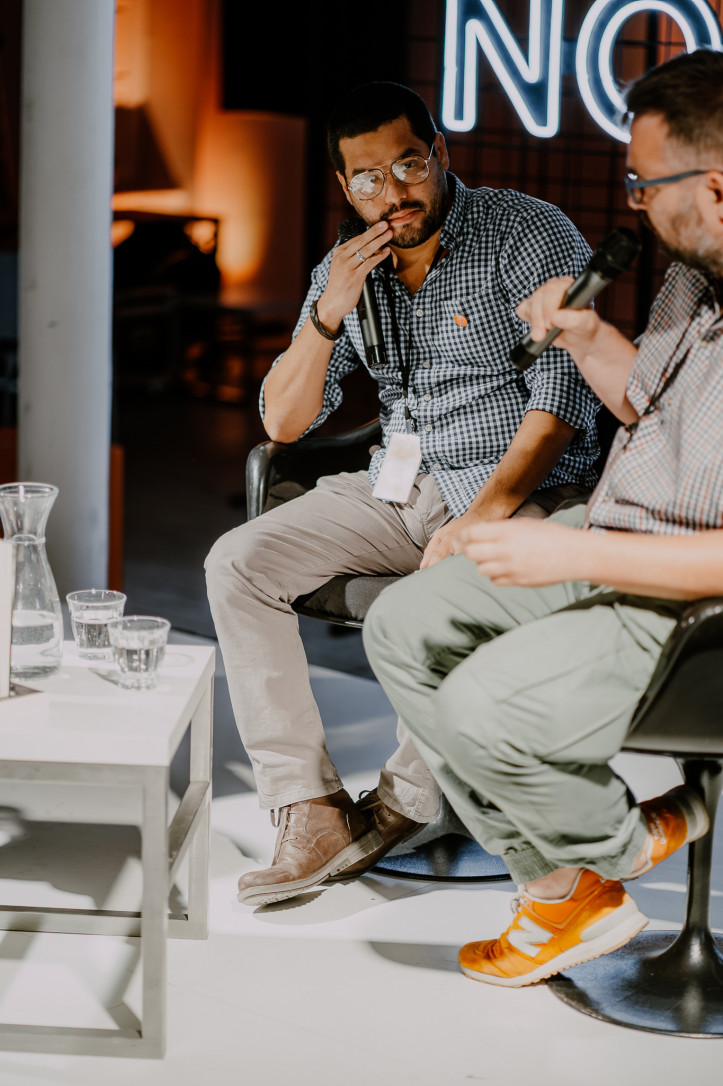
Óscar Martínez:
An award-winning journalist from El Salvador, on the staff of the online newspaper El Faro, whose work has appeared in publications including The New York Times, The Nation and The New Republic.
He has written several books of reportage, including A History of Violence: Living and Dying in Central America and El Niño de Hollywood. He has won numerous awards, including Mexico’s Fernando Benítez Prize, the Maria Moors Cabot Prize awarded by Columbia University and the International Press Freedom Award.
He was a guest at the NON-FICTION reportage festival in Kraków.
Translated by Nathaniel Espino


